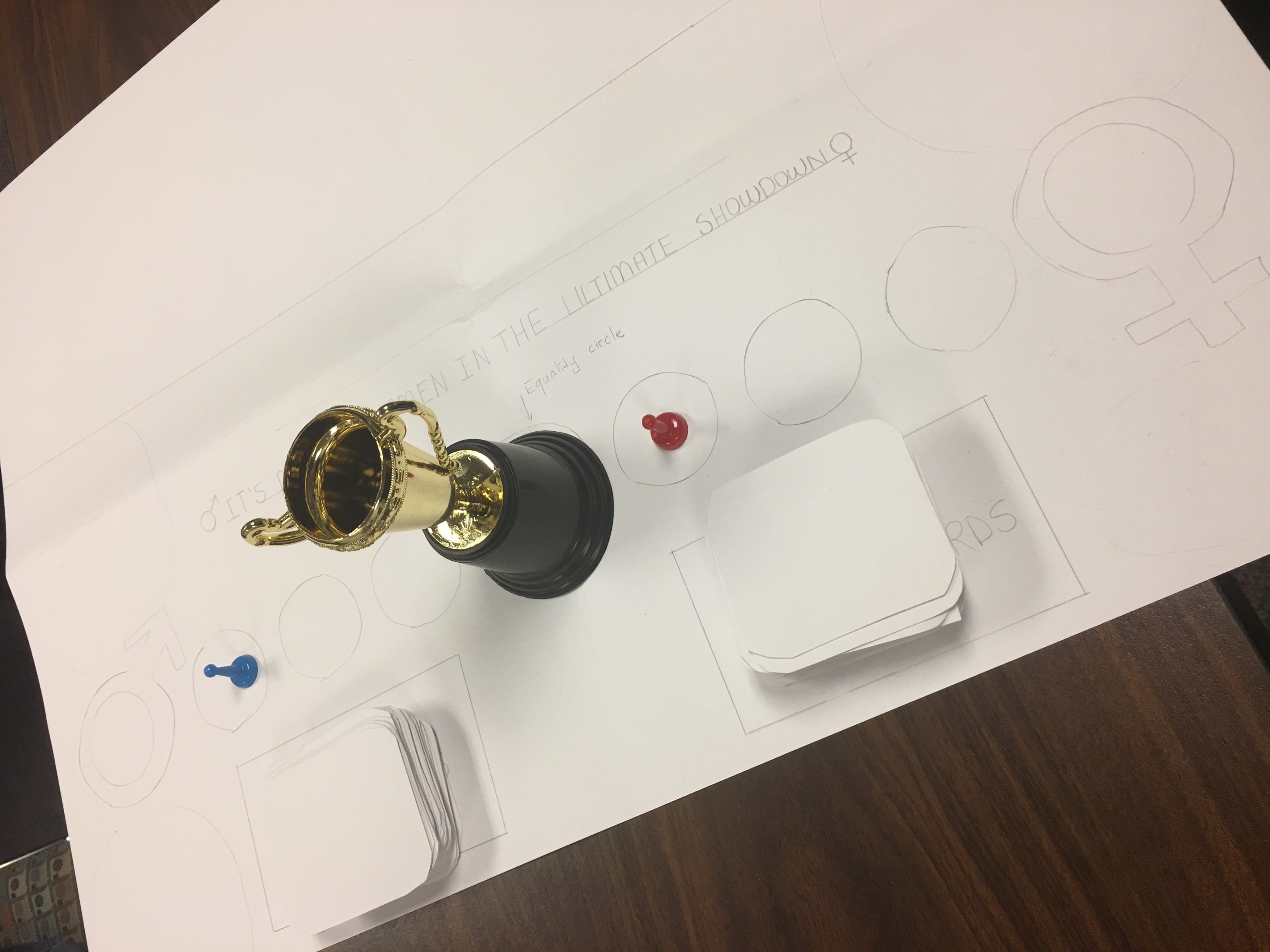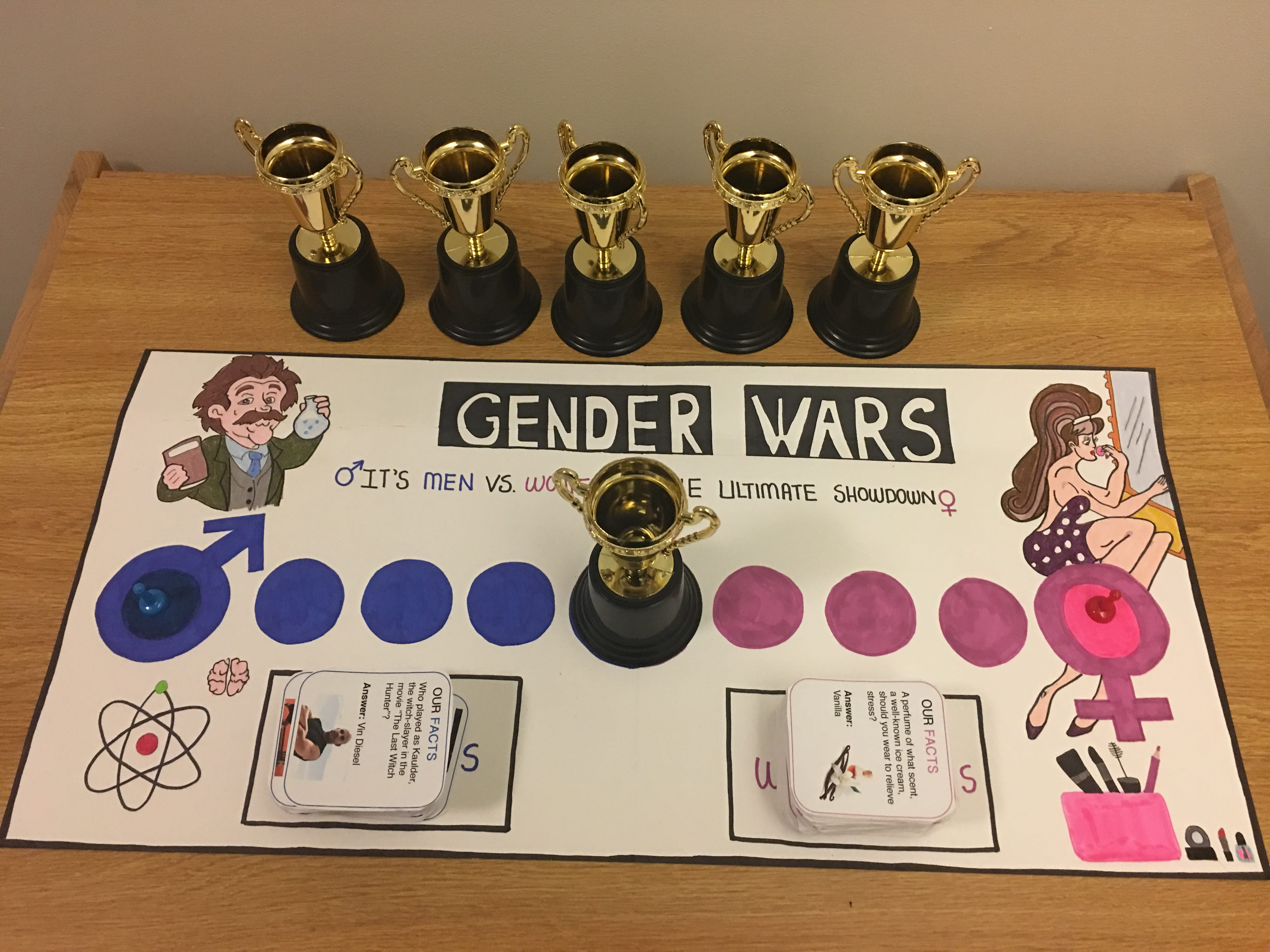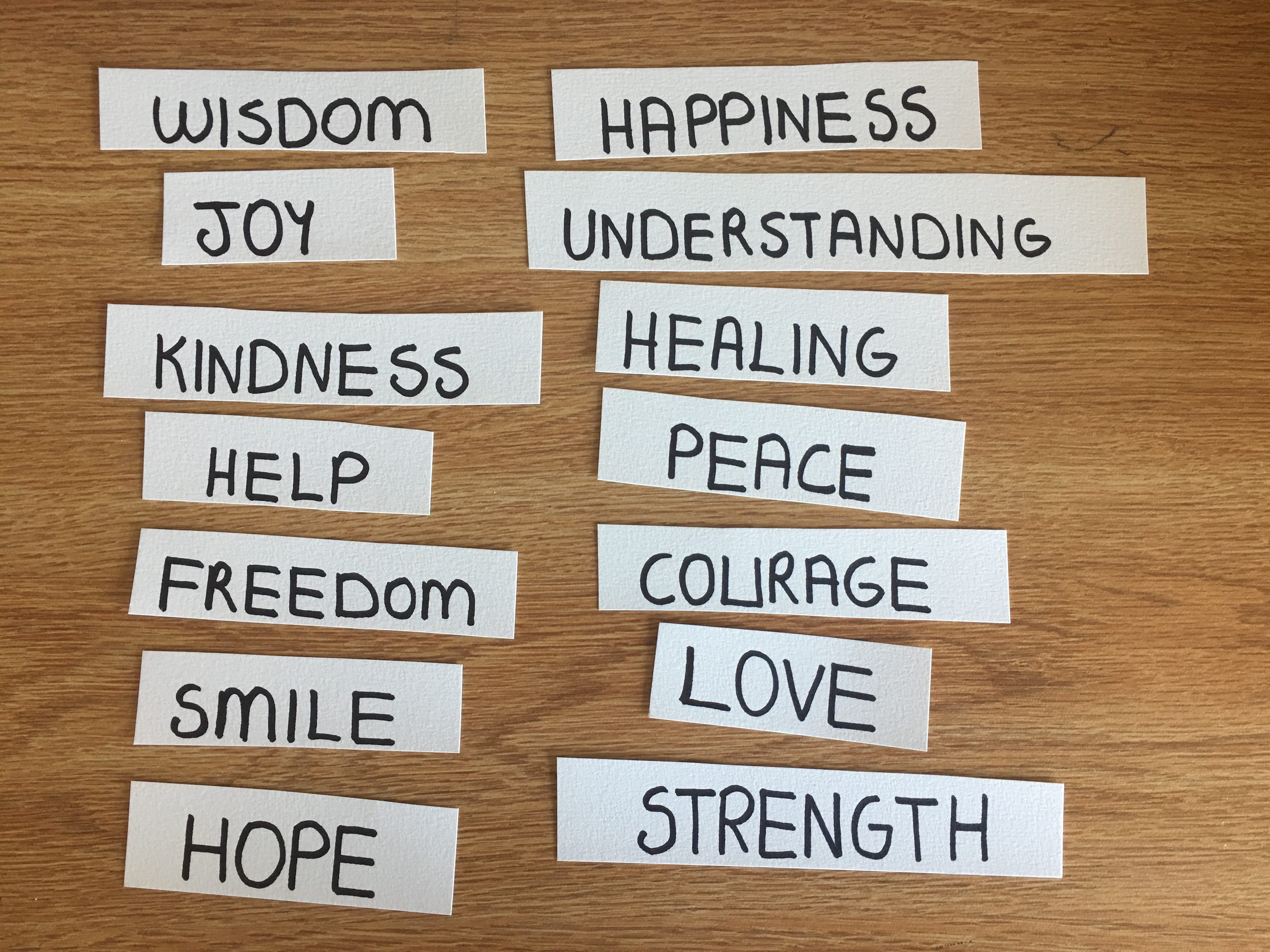Ilayda Hanci
GAME 1850
Final Project: Artwork #4- Experience
Game Design Document: game-1850-final-project
Gender Wars
My board game lets to show what you know about the opposite sex and is based on sexism. First, people choose which team they want to play according to their preferred gender and divide into a guy’s team and a girls’ team. On each turn, a member of the other team asks the playing team the questions on the card. Players take turn on asking the questions. It is men vs. women in a challenge to answer 3 question categories. The first team to capture all three prizes wins the battle and proves that everyone deserves to be equal.
From birth, children are assigned a gender and are socialized to conform to certain gender roles based on their biological sex. Gender roles are based on norms, or standards created by the society. In the U.S., masculine roles are usually associated with strength, aggression and dominance, while feminine roles are associated with passivity, subordination and nurturing. The attitudes and expectations surrounding gender roles are typically based not on inherent or natural gender differences, but on stereotypes about the attitudes, traits or behavior patterns of women and men. I personally think stereotypes are a big problem in our modern society. It puts labels about how a person should act or live according to their sex, race, personality, and other facts. As people try to fit in the roles that society created for them, they don’t learn much about the other roles the opposite sex has. In this game, all the cards and their themes are prepared about general stereotypes that society created over men and women and the gender roles, to show sexism and how people have different areas of interest because of this situation.
Each team mixes all the cards and pick one each turn to ask, and each team moves one space by knowing the answer right. When they pick one card from the deck, they either encounter to an “our facts” card, “our moves” card or “our lives” card. They move 1 space further by knowing the answer right. Each team has in total 1 minute to answer the questions after reading it out loud. If you don’t know how to answer you have 1 skipping choice. After that, you can’t skip any question, so think carefully and spend your time wisely.
Game Requirements:
- Guy’s team of 3 people
- Girls’ team of 3 people
- One host person who keeps track of the time and moves the team’s pawns
- Men Cards: 116 cards in total
- Women Cards: 116 cards in total
- 6 trophies
- Knowledge Cards (68 cards each team): Gender-specific trivia that member of your sex should know. Girls’ team read out loud their gender-specific trivia question and guy’s team has in total 1 minute to answer. It is the same when guy’s team read their questions for girls’ team. There is plenty of time to think so answer it wisely!
Example: What exotic flower is the source of vanilla pods? – girls’ group ask for guy’s group
- Daily Life Cards (24 cards each team): Questions about things that have actually happened in a player’s life. In this card, you have to read the question out loud to the other team, then secretly pick how you would answer. Then, place the card face down on the game board. Guy’s team read the question out loud and girls’ team has in total 1 minute to think and answer since they have only 1 skipping chance. It is the same rule when girls’ team read their questions for guy’s team.
Example: The most important quality I look for when buying a car is:
- Performance
- Styling
- Cost of the car
For the daily life cards, I did a field research to ask people about their daily tasks. I interviewed 10 people including my friends and some strangers who were willing to talk to me. I simply asked 2 questions:
- What do you love to do to spend your spare time?
- Name one specific thing that you know about the opposite sex?
This research process helped me to show how society divided the two genders and pushed them to know and do different things.
Here are the results:
Damla (friend) Mert Ali (friend)
- Reading books 1- Playing Basketball
- Men love cars 2- Girls love messaging
Selin (friend) Mina (friend)
- Shopping 1- Hanging out with friends
- Men love to watch soccer games 2- Boys tend to interested more in engineering
Eda (friend) Deniz (friend)
- Shopping 1- Cooking
- Men love playing games 2- Boys don’t know how to in playstation cook
Burak (friend) Alessia (stranger)
- Playing video games 1- Watching tv shows
- Girls love doing makeup 2- Men love soccer
Can (friend) Jessica (stranger)
- Fitness 1- Jogging and sport
- Girls love watching romantic movies 2- Boys love action movies
Aras (friend) Philip (stranger)
- Watching movies 1- Watching tv shows
- Girls love shopping 2- Girls are into fashion
3. Move Cards (24 cards each team): Both teams perform a gender-specific action. Choose a member of the other team, and give the move cards to one of the members in the opposite side. While she/he tell the action without talking, the team members try to guess it. If they manage to find the action in 15 seconds, they move 1 space further. In this category too, you have 1 skipping choice. If they don’t know the answer in 15 seconds, they move to next round.
Example: Changing a baby’s diaper, cutting wood
When guy’s team pick a moves card from the deck, they give it to the girls’ team to perform their action.
Playing:
On the female team’s turn, the male team draws from the male deck and reads to the female team. On the male team’s turn, the female team draws from the female deck and read to the male team. If one of the teams answers correctly, they move their pawn one space toward the end of the board. The other team draws a new card and reads the new question.
Ending a Round
When your team answers it correctly, you move one space further. If you arrive to the center into the Equality Circle, you won the first prize for the first round. Later on, a new prize will be placed in the center. It is now the other team’s turn.
Winning the Game
The first team to capture all three prizes wins the battle.
Men trivia question themes based on the common stereotypes:
- Sports
- Cars
- Video games
- Science (planet, human body, space, elements)
- Action movies (The Dark Knight, The Avengers, Captain America: Civil War, The Matrix, James Bond, Dead pool, Gladiator, Warcraft, Mission Impossible)
- Technology (IPhone, MacBook, PlayStation, Xbox, IPad…)
- Fitness
Women trivia question themes based on the common stereotypes:
- Shopping (dresses, bags, shoes, jewelry….)
- Beauty (make-up, plastic surgery)
- Cooking
- Romantic Movies (Titanic, The Notebook)
- Books
- Celebrities
- Social media (taking selfies)
- Art, drawing
Play Test
Several play tests were done before the game was finalized. In the first play test, there were 3 circles on the game board. I changed it to 5 because otherwise the game finished quickly. In the second play test, I added more easy fact cards because I found that there were more hard questions and needed to balance the levels of hardness in the cards. With more easy fact cards, the game moved more smoothly.
In the final playtest that I did during the class, I basically changed the game concept. Now, instead of dividing people into girl’s and guy’s team, people can choose their team according to their gender identity and preferred gender. With this new concept, I learned that while playing, guys seem to know only their facts while girls know the facts about the both gender. It seemed very interesting to me that how society pushed men to not be interested into the girl’s stuff.
To do list for the final:
- Change the design of the board
- Add 2 more circles
- Add more cards and put them in a box so people can easily pick them up while playing
Artist Statement
My board game mainly raises awareness about the gender stereotypes that the society created and shows people’s knowledge about genders. The reason why I choose to make a board game about sexism is that, last semester, I have read 3 books in my Gender in Changing society class. This course was mostly considered why and how gender is socially constructed in U.S. society and looked at different theories of gender. We explored gender as an institution as well as different (cultural) expressions of masculinities and femininities. The lectures and books included topics of gender in everyday life as well as gender as an organizing principle in the institutions of families, education, workplaces, sexualities, religion, the media, politics, and forms of gender violence. What I loved about taking this class was the ability to explore and understand the actual meaning of sexism. When you take classes about women studies, you study politics, theory, literature, history, sociology, and psychology, all with a different perspective. Women’s and Gender Studies provide critical thinking skills and an understanding of women’s diverse contributions to society, which are valuable for a wide variety of careers. These type of classes are committed to realizing the equality of women and men in all areas of life so that our relationships, both personal and social, are characterized by the freedom and mutuality which can only occur among equals. You discover and ask questions that no one’s ever challenged you with before: How have women been portrayed in the media and religion? How does our society compare to others in its treatment of women? In what ways do gender stereotypes influence politics and literature?
First off all, designing a game was not as easy as I thought. I sat for an hour to find an idea for my game but actually the idea has to pop-up in to your mind. Finding a theme is just the beginning… If I want to be a game designer, I should be patient.
While preparing my board game, once I found my idea, I followed the same path as I did before for my board game projects in game design class, last semester. My first task was to translate the first raw idea into a designed document. This document was meant to describe the general idea of the game and should give the player a picture of your game. In this part, I determined the age range of my players and decided my mechanics. The designed document was a first treatment of the game, and it’s just the very first step of a miles-long journey.
After this process, I started to prepare my move cards, facts cards and daily life cards because I had to prepare 232 cards total. Then, I prepared my test game and sketched out a rough draft of my board design. Once my testing process is completed, I started on creating the final version of my game. I know that the game board is the main part of my board game, so I made the design to be attractive and I also added cartoons to make it funny.
For this project, I was mostly inspired by the Dada Movement. The feminist Dada artist Hannah Höch, one of the group’s pioneering photomontage artists. Höch critiqued the role of women, beauty standards, marriage, the politics of her home country, Germany, and the Dada group itself.
Schrank Chart
I feel like my game falls onto the diagonal between political and complicit. It falls under this category as there are underlying political motives and real world problems.
Most of my projects that I did for this class were about socialization, communication and interacting with other people because I think, this is the most important aspect in a game. Games don’t need to be overtly academic to be educational, however. Just playing them, board games can teach important social skills, such as communicating verbally, taking turns, sharing, waiting, and enjoying interaction with others. My first piece, “Daydreamer”, gave me the ability to look at any situation from a different point of view. Since this game played in two teams and had to create a story from the drawings, it encouraged people to talk and socialize. This game is very similar to Exquisite Corps in that it is a group effort. It is a bit different because half of the progression of the art is hidden from the artist as team mates create a story together while both teams can’t see the whole story.
My second piece “Reassemble Reality” was an appropriation game. It is inspired by Marcel Duchamp’s famous readymade L.H.O.O.Q from the book DADA. This game also helps people to interact with one another while creating their own paintings by collecting materials. At the end of the game, they show their work of art to each other and explain their concept. The painting that gets the most attention from the audience, the artist of that piece earns the privilege to be the leader of the Dada movement.
My third piece, “Good Vibes” was an intervention game. In this project, the goal was directly intervening with people’s needs and desires about what they want in their life and what they desire the most to get. By my friendly and welcoming design of the board, I saw people pointing and laughing when they picked a word from it. By seeing that, I accomplished my task of simply motivating people and make them happy. I mostly influenced by Yoko Ono’s pieces as she asks the question to audience and lets the audience to create the piece. She definitely has a different style to impact people with her acts and pieces, and I followed her path in this project.
Overall, this class helped me to think outside the box by learning about many artistic movements that succeeded being different from others. Being creative and different is very crucial to be a successful game designer and this class helped me to develop these skills by giving me the opportunity to make different games which helped me to know how the players felt while they were playing.
Pictures:



Final Design



























